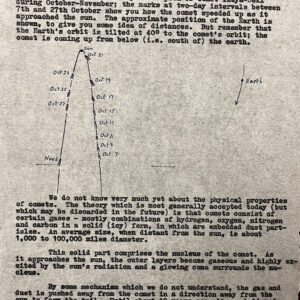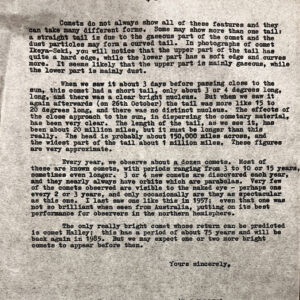
Newsletter Sign Up
Sign up today to our quarterly newsletter
View more
I often receive handwritten letters from more mature members of the public, many of them from country locations, and I afford them a handwritten reply on paper with a fountain pen, popped into an envelope and with a stamp affixed…. It is still an enjoyable experience.
Recently, I was continuing my job of searching through archive boxes of loose information that are effectively historical records of the Observatory’s work, which I then pass on to Carol Wolf and Carol Korb, our Librarian and Archivist, respectively, for formal filing and ultimately digitising by Dave Labrook (Heritage Assistant). The item attached was a 4-page foolscap handwritten response to a member of the public on the topic of Comet Ikeya-Seki in 1965. I was reminded of how much time was taken by the Government Astronomer to investigate the history of the discovers, draft up a response, have it typed and then add the wonderful hand-drawn annotations. How did we do this all without computers! You will note that we were still using miles in those days, and our understanding of several comments Harris made is now a fully proven theory as opposed to a hypothesis; some remain a mystery; we were also still at Mt Eliza in the City.

|

|

|

|
Banner Image: Comet Ikeya-Seki, 1966. Image Credit: Roger Lynds/NOAO/AURA/NSF

Sign up today to our quarterly newsletter
View more
Let others know of your experience
View more
Become an awesome volunteer
View more